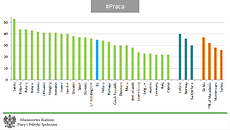Go to main menu | Go to submenu | Skip to content
Employment and counteracting unemployment
Women in managerial positions
08-01-2018Qualifications of Polish women
Women in Poland have appropriate qualifications and motivations to occupy key managerial positions. The Eurostat data shows that more than 76.8% of working women have secondary or higher education (when compared to working men – 59.8%), which puts them in the lead of Europe. The proportions between women and men in the area of education are also represented by the ratio of the number of women-university graduates – more than 64% of all university graduates are women (Higher education in the academic year 2016/2017 preliminary data, CSO 2017)
Women in managerial positions
Despite better education, women in high positions are not represented in such large numbers as men. When we look at the share of women in middle managerial positions, in Poland the representation of women is quite high – 44%, which puts us in the lead of the European Union countries, where, on average, only every 3rd woman takes such a position[1].
According to the European Commission data, concerning the share of women in top managerial positions, related to the power in companies, in 2016 in the management boards and supervisory boards of the largest companies listed on the Polish stock exchange we have 12% of women while the EU average is nearly 16%[2]. On the other hand, the analysis carried out by the international consulting company Deloitte shows that the managerial positions of those bodies there were, respectively, 7.8% and 6.3% of women[3]. In the last few years, these indicators have shown a slight downward trend.
Reasons for the lower presence of women in decision-making bodies
There are many studies and analyses indicating the most common barriers for women to be promoted to higher positions. We are talking about the phenomena of „glass ceiling” or „sticky floor”[4] which maintain and strengthen the barriers and make it harder for women rather than men to apply for higher positions and be promoted. The most frequently mentioned reasons for this situation include: difficulties in balancing working life with family life and prejudices, which both to women themselves and their environment, suggest lower qualifications and predisposition of women to be managers and directors.
[1]Data for 2014, Eurostat press materials Eurostatu 38/2017 Women in managerial positions, http://ec.europa.eu/eurostat/documents/2995521/7896990/3-06032017-AP-EN.pdf/ba0b2ea3-f9ee-4561-8bb8-e6c803c24081
[2] European Commission, 2017 Report on equalitybetween women and men in the EU,
http://ec.europa.eu/newsroom/document.cfm?doc_id=43416tween women and men in the EU
[3] Deloitte, Women in the boardroom. A global perspective, https://www2.deloitte.com/content/dam/Deloitte/za/Documents/technology-media-telecommunications/za_Wome_in_the_boardroom_a_global_perspective_fifth_edition.pdf
[4]Glass ceiling – invisible barriers making it difficult for women to occupy high positions in politics or business, regardless of (or as opposed to) their competence; sticky floor – term referring to the low-status professions without many possibilities to get promoted. These are feminised professions, e.g. secretary, beautician, dressmaker, nurse or housemaid.






